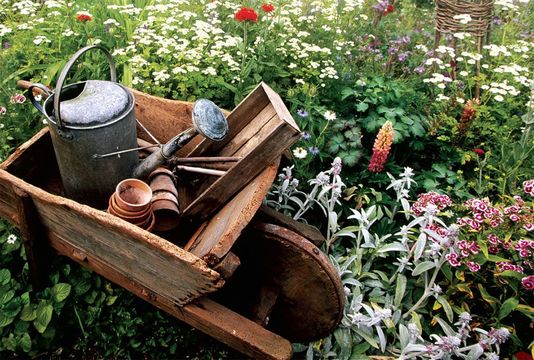
Sian Ellis put the question to Gloucestershire-based garden designer Jacquie Gordon, for surely she would know, having won a Gold Medal at the Chelsea Flower Show for Mr. McGregor’s Garden, inspired by Beatrix Potter’s Tale of Peter Rabbit.
It boasts classic features such as a vegetable patch, an old apple tree, a potting shed and a pond where the white cat sat. Gordon judges at horticultural shows from Hampton Court Palace to Tatton and has made her name creating small traditional gardens.
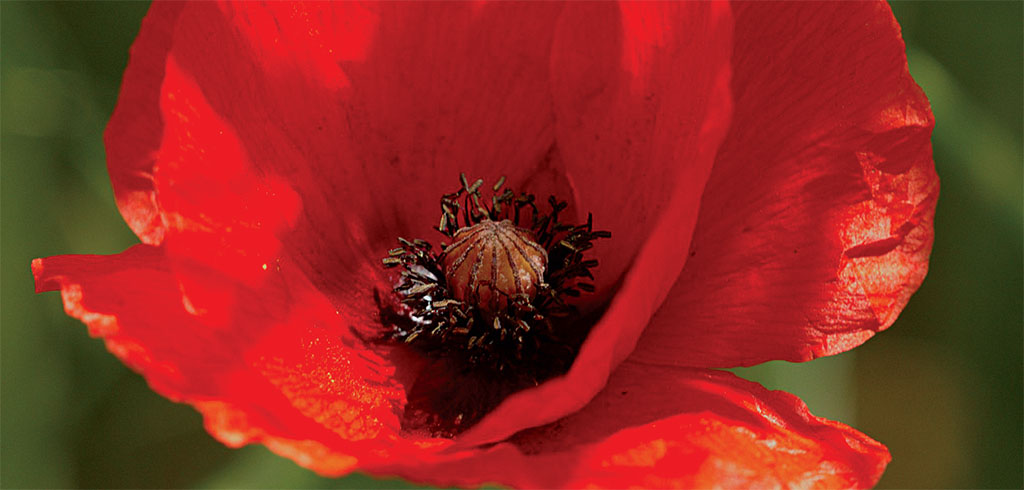
From Kent to Cumbria, the homely cottage garden is one of the best-loved icons of England. WEIDER HISTORY GROUP ARCHIVE
"The whole idea of an English cottage garden is that it wasn’t and isn’t designed,” Gordon says. “They were made by the people for the people. They’re small scale and tend to contain plants that you can raise from seed or you have been given as cuttings, not bought as a self-conscious, quick fix from a garden center. Cottage gardens evolve over time and with randomness. There’s nothing artificial about them.”
Mmm. Let’s try a description, then. What is an English cottage garden? “They’re very specific, a very particular image, quite unique to England in their quirkiness,” the garden designer says.
“They’re not about keeping up with the Joneses; they don’t bother with the latest fashions. They’re personal and can be quite eccentric. But somehow the scale and proportion is right. There are riotous colors and it doesn’t matter if, say, red is next to orange—it works.”
We agree on the chocolate box, romantic vision of Victorian painters like Helen Allingham: closely-packed, haphazard plantings of flowers, fruit, and vegetables; old-fashioned roses curling willfully around the cottage door; lavender ready to release its fragrance as someone brushes past along a narrow path; birds plucking at berries. Overall, a sense of homely privacy, warmth, and tranquility in a higgledy-piggledy haven.
It’s a start, anyway. As Gordon points out: “It’s a rather idealized and nostalgic vision even in Victorian times: the idea that, while Britain is being industrialized, let’s all rush back to our cottage gardens and tend our hollyhocks. Cottage gardens have always fulfilled a need and they always will.”
To better understand these quintessential English gardens that won’t be constrained by design or definition (and stand in complete contrast to the grand schemes that molded wealthy estates), it’s useful to cast a look back over their evolution. Garden designer/garden historian Michéle Seddon-Harvey of Herefordshire explains: “Medieval country dwellers didn’t have the luxury of what we today would call a cottage garden. They didn’t grow many flowers and veg, but they would have kept animals to feed themselves.” Geoffrey Chaucer gives a glimpse of this peasant’s close or miniature farmstead in his Canterbury Tales: a stick-fenced yard where a cock, hens, geese, cows, hogs and the like roam (“The Nun’s Priest’s Tale”). Herbs—fumitory, caper, spurge—are incidental.
Jon (the) Gardener’s 15th-century verse treatise The Feate of Gardening, considered the first practical manual of English gardening, lists nearly 100 cottage plants, mainly herbs and native wildflowers that would have served a medicinal or culinary purpose: including centaury, comfrey, feverfew, and pimpernel. By the 16th century, farmer-poet Thomas Tusser is noting more than 100 species of herb for the housewife to grow, for physic and pottage. There would have been salad plants such as self-seeding borage, marigold and poppy, and at midsummer the garden, though utilitarian, would have been a bright muddle of color. Plants grown primarily for decoration also peep through in Tusser’s frequently reprinted A Hundreth Good Pointes of Husbandrie (1557): roses, nigella, and carnations. “And there would have been fruit trees,” Seddon-Harvey adds. “People in medieval and Tudor times liked their fruit.”
From Elizabethan times, travelers abroad increasingly brought back new varieties of plants and vegetables like the potato, which gradually filtered into rural plots. And over the next century, as the living standards of tenant farmer and villager rose, so the concept developed of cottage gardens as things of beauty as well as sources for table and medicine cupboard. By the late 17th century, agriculturalist John Worlidge could declare there was, “Scarce a cottage in most of the southern parts of England, but hath its proportionate garden, so great a delight do most men take in it.”
And then along came the Victorians and the aspirational, enterprising middle class. Cottages now were not just for the humble and working class. “That’s when the cottage garden became idealized and romanticized, in all those quaint pictures full of masses of flowers with playing children and kittens,” Seddon-Harvey says. Irrespective of this sentimental conceit, the essential marriage of practical and pretty had thoroughly rooted itself in British hearts: the charming mixed plantings and hugger-mugger style of flowers tucked in among the veg, or fruit trees hiding a rustic seat.
Until recently Seddon-Harvey ran a plant-selling business that included a History Garden depicting green-fingered fashions through the ages. One of the most popular plots among visitors was a Timeless Cottage Garden, where fruit trees mingled with black currant bushes, and foxgloves, peonies, pinks, primroses, daylilies, and other old-fashioned favorites scented the air. A cherry tree, rhubarb, and hollyhocks were cozy neighbors.
“Of course these days, people often have separate vegetable and flower plots, not something authentically haphazard, and they do like their grass or lawn, which would have been a luxury totally out of place in a true cottage garden,” she says.
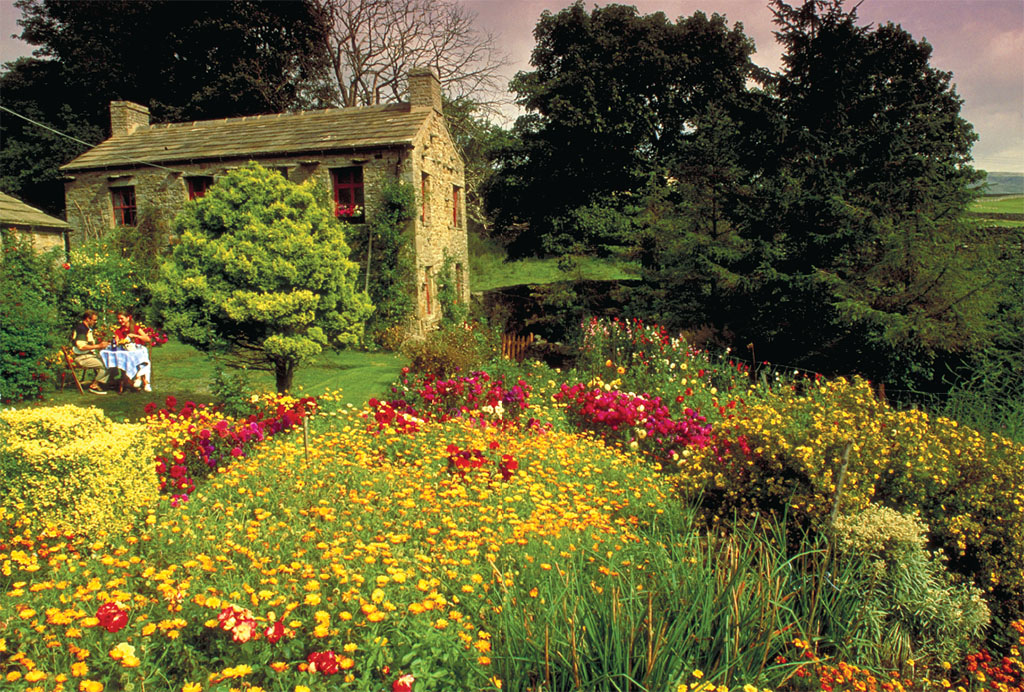
WWW.BRITAINONVEW.COM
Gordon agrees, explaining that although Britons remain in love with cottage gardens, their busy lifestyles mean they often don’t have the time to cultivate them. The paradox is that, despite any nonchalant, untamed appearance, “cottage gardens are high, high maintenance,” she says.
“You need to be out there pottering much of the time. A client never asks me for a high-maintenance garden unless they are wealthy and have a lot of staff. Most people want to plant things in groups of five or six that cover the ground. A cottage garden is an opposite: You have lots of single things that are put in every year, not the perennials and shrubs that stay there all the time.” (Incidentally, neither Gordon’s nor Seddon-Harvey’s personal gardens are cottage gardens!)
“Realistically, if you’re after the cottage-garden look, it’s better to create it in part of your garden, for example, a border that has the right image, rather than trying to make the whole of your garden like it,” Gordon continues. “Even my Beatrix Potter garden for Chelsea was conceived as part of a bigger, formal garden. It’s elements of the cottage garden that are always popular among the clients I work for. Scented roses, honeysuckle and lavender evoke something very deep in people. And they like the small scale. It’s a reaction against pressure and the hours people work. They want to come home to a garden and for it to be pretty and safe and private.”
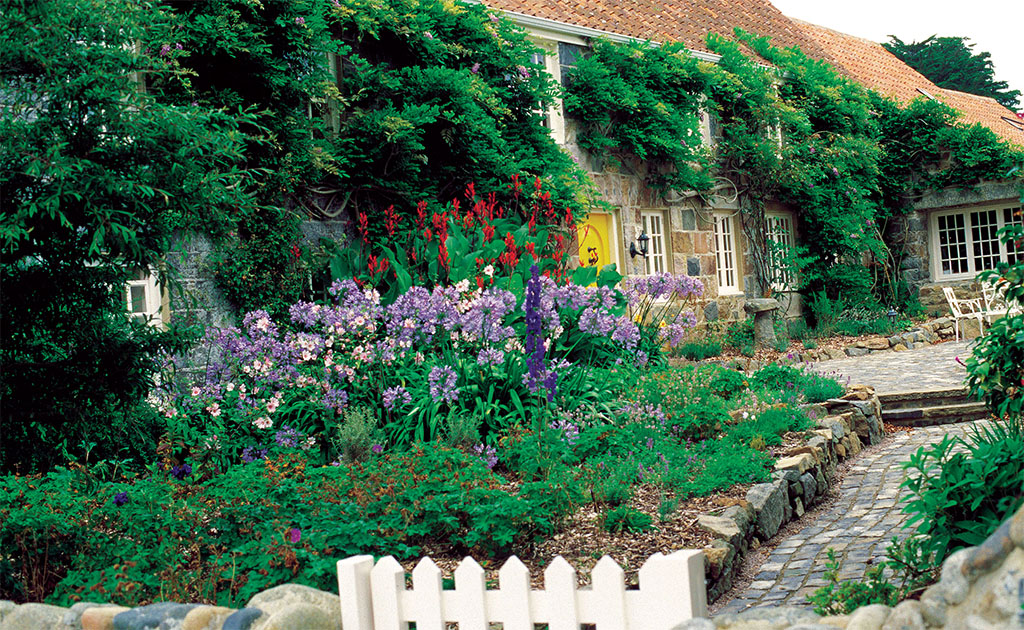
“Picture gloriously fragranced honeysuckle around the porch, purple-blue wisteria stretched across the wall of your house, a rose-drenched arch or pergola creating a snug corner.” BRITAINONVIEW/VISIT GUERNSEY
So, setting aside the conundrum that cottage gardens aren’t designed but “happen” over many years, what elements should someone consider when seeking to capture their spirit? “Principally, I would enclose a garden or space, and make it inward-looking,” Gordon says. “It would be divided up, but not into self-conscious areas. Paths would be practical so that you can get a wheelbarrow around them; flower and veg beds would be so many spade widths apart. The emphasis is on practicality and sustainability.”
Breaking the task down further into ingredients, cottagers need to think about layout, plantings, and features. At the risk of repetition, our humble forebears would not have had the space to separate different parts of their garden into areas for flowers or vegetables. This truly jumbled garden is probably beyond most of us, but mixed patches work well. “The key is to convey the difference between drifts of color-coordinated, selected plants in, say, an herbaceous border, and a cottage garden border that might include some vegetables, some herbs, some shrubs, some cut flowers,” Gordon says.
As to your choice of flowers: In the past, people would have grown whatever was local to their area. Some would be uninvited guests, wind-blown in from field and lane, or introduced by birds. And after all, wild primroses beneath the garden hedge look every bit as charming as more sophisticated species.
“Traditional cottage garden plants include shrub roses, peonies, lupins, delphiniums, lavender, poppy, iris, honeysuckle, to suggest a few,” Gordon says. “These days it can be difficult to buy basic original species because you’ll usually find named varieties, but you can create the right impression.”
Soil type, climate, and availability of flora notwithstanding, that impression is: variety and plants that appeal to all the senses; overhanging climbers and shrubs crowding beside paths and inviting touch; memory-stirring scents. Birds, bugs, butterflies, and beasties love this, too.
With a nod to self-sufficiency, your sunny fruit patch might include gooseberries, red currants, black currants, raspberries, and rhubarb, with a row of nasturtiums or sweet peas to muddle it up a bit. If you’ve room, an apple or pear tree will balance early croppers like rhubarb with autumn goodies.
“The cottage garden was essentially a late spring to autumn affair peaking in summer,” Gordon says.
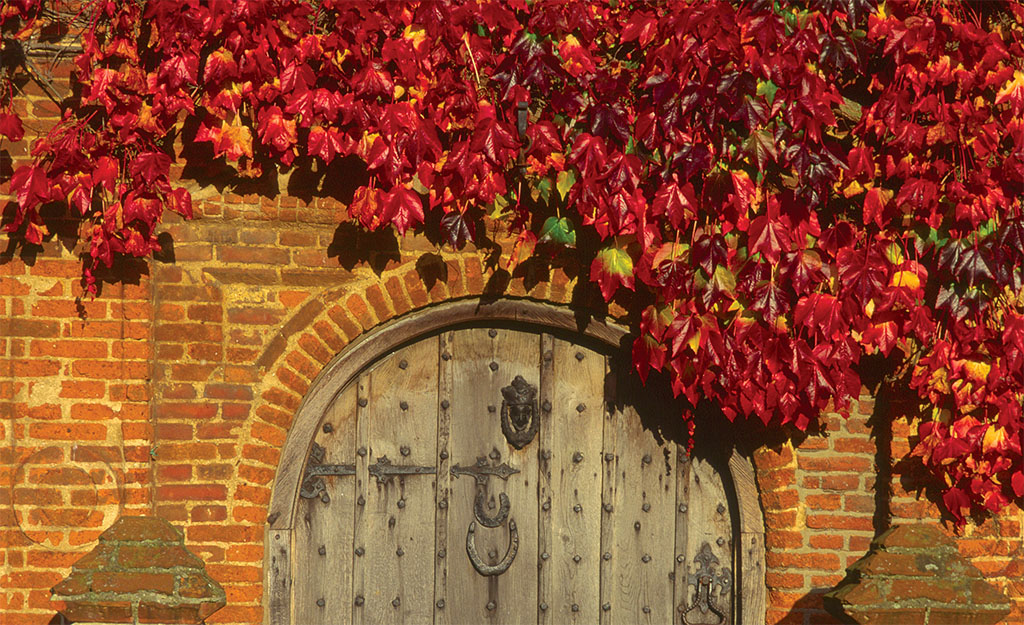
Traditionally, local building materials would enclose the garden with a hedge, fence or wall. BRITAINONVIEW/ROD EDWARDS
Your vegetable patch, once the hub of the cottage garden, could feature a seasonal mix of runner beans, pumpkin, tomatoes, cauliflower, Brussels sprouts, cabbages, leeks, beetroot, onion or carrot. Again, slightly hotch-potch it up with herbs: basil around the bush tomatoes, chives alongside the carrots, thyme, sage, and dill flanking the brassicas. They will enhance the sight and smell of the plot and also liven up your soups and salads.
On, next, to features and structures. “I would have some kind of enclosure around the garden or area—a hedge, fence, or wall,” Gordon says. “Traditionally, local materials would have been used: stone walls in the Lake District or Cotswolds, for example. Elsewhere you might have had brick. It’s all about being vernacular.” Perhaps ivy tumbles over the wall, or bluebells, violets, and primroses clump beneath. A hedge of hips and haws is a great autumn treat for birds. If you opt for a fence, make sure it exudes rustic charm, nothing too pristine. Cottage gardens were essentially tended by the budget-conscious.
“You wouldn’t have vistas leading to statues,” Gordon continues. “Views are small scale and the features are mainly the plants. So you would probably have something over which they can scramble, whether a front door, arch, pergola, or gate.” Picture gloriously fragranced honeysuckle around the porch, purple-blue wisteria stretching across the wall of your house, a rose-drenched arch or pergola creating a division or snug corner.
You certainly wouldn’t have any formal sitting area, patio or lawn—the cottage-dweller had no time for lounging—but maybe a rough-hewn seat or bench hidden away through the rose arch or beneath a tree would be just the ticket for resting your limbs before returning to the difficult task of digging the vegetable patch. Eventually, you’d put away your tools in a little potting shed, reached by a narrow path of flagstones or gravel (nothing too grand, ash sufficed in days gone by).
Conclusion
In conclusion, pick the plants and props that suit you and your locale, the climate, and soil. And if you seek more inspiration, travel to England. “You can see a whole range of different [private] cottage gardens in Cotswold villages like Chipping Campden, Great Tew, and The Slaughters,” Gordon says. Or flip through The National Garden Scheme’s The Yellow Book for a guide to thousands of gardens that open for charity (www.ngs.org.uk); it includes some gems, “though they are generally gardens that have been designed by their owners,” she adds.
Read more
* Originally published in July 2007.





Comments